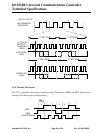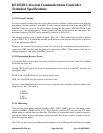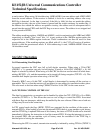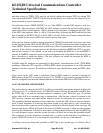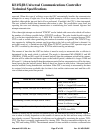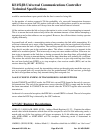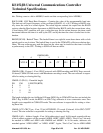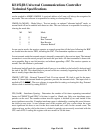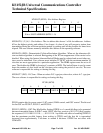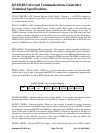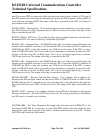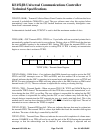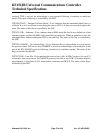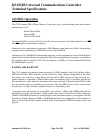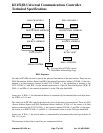
KS152JB Universal Communications Controller
Technical Specifications
Kawasaki LSI USA, Inc. Page 70 of 120 Ver. 0.9 KS152JB2
can be masked in AMSK1:AMSK0. A received address of all ones will always be recognized in
any mode. The user software is responsible for setting or clearing this flag.
GMOD.5,6 (M0,M1) - Mode Select - Two test modes, an optional “alternate backoff” mode, or
normal back-off can be enabled with these two bits. The user software is responsible for setting or
clearing the mode bits.
M1 M0 Mode
0 0 Normal
0 1 Raw Transmit
1 0 Raw Receive
1 1 Alternate Backoff
In raw receive mode, the receiver operates as normal except that all the bytes following the BOF
are loaded into the receive FIFO, including the CRC. The transmitter operates as normal.
In raw transmit mode the transmit output is internally connected to the receiver input. The internal
connection is not at the actual port pin, but inside the port latch. All data transmitted is done with-
out a preamble, flag or zero bit insertion, and without appending a CRC. The receiver operates as
normal. Zero bit deletion is performed.
In alternate backoff mode the standard backoff process is modified so the backoff is delayed until
the end of the IFS. This should help to prevent collisions constantly happening because the IFS
time is usually larger than the slot time.
GMOD.7 (XTCLK) - External Transmit Clock -If set an external 1X clock is used for the trans-
mitter. If cleared the internal baud rate generator provides the transmit clock. The input clock is
applied to P1.3 (
T X C). The user software is responsible for setting or clearing this flag. External
receive clock is enabled by setting PCON.3
IFS (0A4H) - Interframe Spacing - Determines the number of bit times separating transmitted
frames in CSMA/CD and SDLC.A bit time is equal to 1/baud rate. Only even interframe space
periods can be used. The number written into this register is divided by two and loaded in the
most significant seven bits. Complete interframe space is obtained by counting this seven bit num-
ber down to zero twice. A user software read of this register will give a value where the seven
most significant bit shows a one for the first count-down and a zero for the second count. The
value read may not be valid as the timer is clocked in periods not necessarily associated with the
CPU read of IFS. Loading this register with zero results in 256 bit times.



